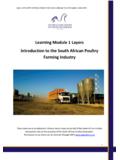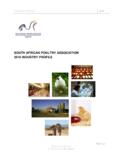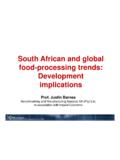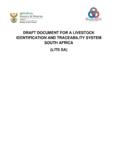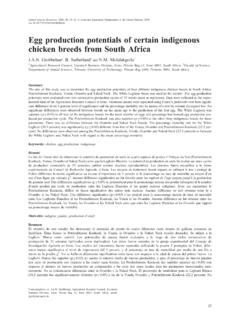Transcription of Evaluation of Growth and Yield of (Capsicum annum …
1 Received: 7 March, 2011. Accepted: 31 August, 2011. Original Research PaperThe african Journal of Plant Science and Biotechnology 2011 Global Science Books Evaluation of Growth and Yield of (Capsicum annum L.) var Nsukka Yellow under Different Fertilizer Regimes in Ibadan, South-western Nigeria Alaba T. Fariyike* Oyeboade S. Adebayo Gbenga S. Akinwumi Olufemi T. Ademoyegun Catherine A. Akinpelu Esther A. Adesegun National Horticultural Research Institute, 5432, Ibadan, Oyo State, Nigeria Corresponding author: * ABSTRACT Capsicum annum (L.) var Nsukka Yellow is a spice crop in high demand and which commands a high price in the South Eastern parts of Nigeria because of its bright yellow colour and aroma which distinguishes it from other pepper varieties.
2 The production of this spice crop should not be restricted to this region alone; it should be extended to other parts of the country with the use of adequate fertilizer. Therefore, a field trial was conducted at the National Horticultural Research Institute, Ibadan, South Western Nigeria to assess the Growth and Yield of this pepper under different fertilizer regimes. The experiment was laid out in a randomized complete block design with four replications. Treatments used were control (no NPK or poultry manure), 15 t/ha poultry manure, 30 t/ha poultry manure, 45 kg/ha NPK 15: 15: 15, 90 kg/ha NPK 15: 15: 15 and 15 t/ha poultry manure + 45 kg/ha NPK 15: 15: 15. Data were collected at two-week intervals. Results showed that the combination of poultry manure and NPK fertilizers (15 t/ha + 45 kg/ha) was the best in terms of plant height, number of leaves, stem girth, main branch and Yield compared to the control.
3 Yield was significantly (P < ) influenced by different fertilizer regimes. A Yield of , , , , and t/ha was obtained in combined fertilizer, 90 kg/ha NPK 15: 15: 15, 45 kg/ha NPK 15: 15: 15, 30 t/ha poultry manure, 15 t/ha poultry manure, and the control respectively. _____ Keywords: Evaluation , fertilizer rates, location, Nsukka yellow pepper Abbreviations: PM, poultry manure, WAT, weeks after transplanting INTRODUCTION Pepper (Capsicum annum L.) is an important vegetable in the world, both in tropical and temperate regions. In Nigeria, it is regarded as third most important vegetable after onions and tomatoes (Odedina et al. 2006). It is an important source of vitamins A and C. Nigeria is the largest producer of pepper in Africa, with production of 452,673 metric tonnes accounting for about 50% of the african production (FAOSTAT 2009). Its consumption accounted for about 20% of the average consumption per person per day in Nigeria (Erinle 1989; Alegbejo 2002).
4 It is characterized by its yellow colour at fruit ripening and a unique aroma, which distinguishes it from other pepper varieties; 1-3 fruits occur in the axil of one leaf. There is also a myth that it loses its aroma if planted in other parts of the country (Amakor 1994). However, most of the research activities have been on other pepper varieties and limited mostly to the Northern part of the country (Olanrewaju and Sowe-mimo 2003). However, production of a particular variety, Nsukka Yellow is mostly cultivated in the Eastern states of Nigeria, notably in Nsukka and Enugu areas, and is not very common in riverine areas. It is eaten raw in salads and cooked in various ways (Purseglove 1991). Plants, like other organisms, require nutrients for their Growth and reproduction. However, the use of inorganic fer-tilizers alone cannot guarantee sustainable Yield of the crop, hence the need to be complemented with organic fertilizer (Alasiri 2002).
5 Nutrients are needed for normal plant Growth and to maintain healthy life, roots and vegetative Growth and the developments of crops (Tittonel et al. 2008; Aruna et al. 2009). The quantity and quality of applied nutrients taken up by plants are determined to a large extent by the way in which the nutrient carrier is presented to the plant (Awe et al. 2009). However, pepper is reported to respond to im-proved soil fertility (Yahaya 2009). In order to achieve high Yield in pepper, there is a need to augment the nutrient status of the soil to meet the crop s needs and thereby maintaining the fertility of the soil. This is achievable with adequate nutrients in the soil and their proper management (Tittonel et al. 2008; Adebayo et al. 2009). One way of increasing the nutrient status is by boos-ting the soil nutrient content either with the use of organic materials such as poultry manure, animal waste and the use of compost or with the use of inorganic fertilizers (Dauda et al.)
6 2005). The application of manure fortified with inor-ganic fertilizer was also advocated to increase soil concen-tration of nutrients and organic matter (Eghbal 2002). Soli-man and Hassan (2004) also observed that the application of organic materials wither alone or in combination with chemical fertilizers increased the soil availability of N, P and K. Poultry manure is very cheap and effective as a source of N for sustainable crop production, but its availability remains an important issue due to its bulky nature, while inorganic fertilizer is no longer within the reach of farmers with poor resources due to its high cost (Rahman 2004). However, John et al. (2004) advocated for the integral use of organic manure and inorganic fertilizers to supply ade-quate quantities of plant nutrients required to sustain maxi-mum crop productivity and profitability, while minimizing the environmental impact for nutrient use.
7 There is there-fore a need to evaluate the effect of integration of both or-ganic and inorganic fertilizer on the performance of pepper var Nsukka Yellow in the South western region of Nigeria. The african Journal of Plant Science and Biotechnology 5 (1), 46-49 2011 Global Science Books MATERIALS AND METHODS A field experiment was conducted at the National Horticultural Research Institute, Ibadan, Nigeria. The location lies at 03 35 E, 07 24 N, 168 m above sea level in the rainforest transition zone of South Western Nigeria. Pepper seedlings were raised in a nur-sery with sterilized top soil and cured poultry manure. The top soil was sterilized by adding the desired amount of soil in an oven roasting bag, add some water to the soil to keep it moist, tie the mouth of the bag and make an opening for thermometer. The soil bag was placed on the pan and heated between 160-170 C for about 30 min (a thermometer was used to check the soil tempera-ture).
8 The sterilized soil was removed, cool thoroughly before planting. Seeds were planted 5 cm apart, then the holes were covered with a thin layer of soil and lightly watered; sowing depth was about 5 mm. Nursery trays were placed under shade to protect the seedlings from direct influence of rain drops. Watering in the nursery was on every other day. Germination commenced a week after planting in the nursery. Prior to planting, soil samples were taken at a depth of 0 to 15 cm from different parts of the field and thoroughly mixed to form a composite sam-ple. The soil sample was air dried and passed through a 2-mm then a sieve to assess soil texture and for chemical analyses. The sample was analyzed for pH, organic carbon (C), total nitrogen (N), available P, exchangeable Ca, K, Na and Mg. The pH of the soil sample was determined with glass electrode pH meter using a 1:1 soil-water (solution) ratio in distilled water as reported by Bates (1954), organic C determination was by using the wet oxidation method of Walkley black (1934), total N by the regular macro Kjeldahl method (Bremner 1965), available P determined by the Bray P-1 method (Bray and Kurtz 1945) while exchange-able Ca, K, Na and Mg was analyzed with flame photometry (Pratt 1965).
9 The seedlings were transplanted to the field after 4 weeks. Transplanting was done with a hand fork and with ball of earth around the roots. Each plot measured 2 m 2 m with an inter-plant spacing of 30 cm 75 cm with 18 plants per plot. The ex-perimental design used was a randomized complete block, with six treatments (including a control with no fertilizer or poultry manure) and four replications. Treatments used were: a) Control (no fertilizer or poultry manure); b) Organic fertilizers (poultry manure) 15 t/ha and 30 t/ha at 2 split applications; c) Mineral fertilizers (NPK 15: 15: 15) 45 and 90 kg/ha at 2 split applications; d) Combined fertilizers (poultry manure + NPK 15: 15: 15) 15 + 45 kg/ha at 2 split applications. Missing stands were supplied five days after transplanting. The treatments were applied on split applications, first 2 weeks after transplanting and then at the flowering stage.
10 Data collected included plant height, number of leaves, stem girth, main branches and Yield (t/ha) and were subjected to analysis of variance using a linear model procedure of statistical analysis (SAS Institute 2003). Mean were compared using least significant difference (LSD) at P = RESULTS AND DISCUSSION The chemical composition of the poultry manure used is presented in Ta b l e 1 while the soil physico-chemical pro-perties before the experiment are presented in Ta b l e 2. The latter showed that the fertility status is average, especially for major elements. There were significant treatment effects on the vegeta-tive Growth of pepper (Ta b l e s 3 - 6). Four weeks after trans-planting, pepper plants that received a combination of poul-try manure and inorganic fertilizer (NPK 15: 15: 15) were significantly taller than plants from other treatments tested. The shortest plants were control plants ( , no fertilizer treatments).

